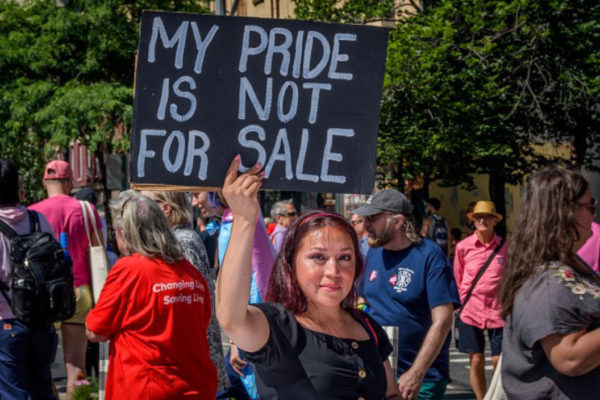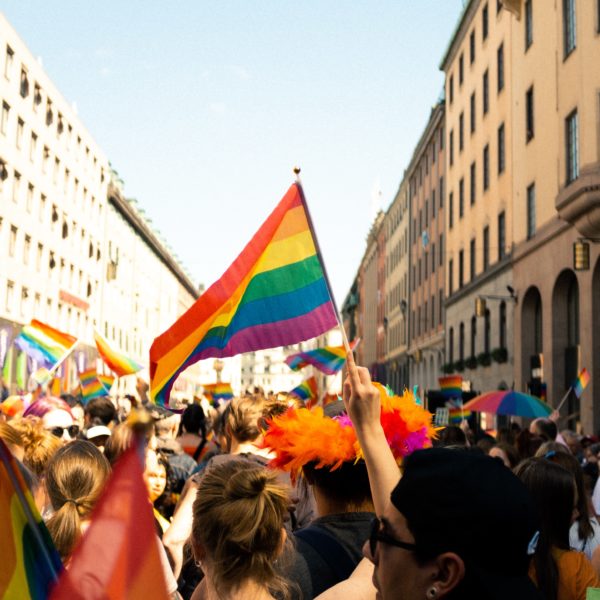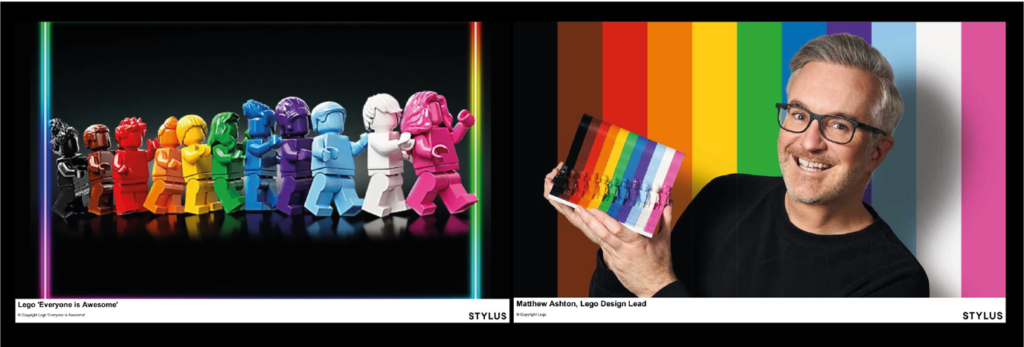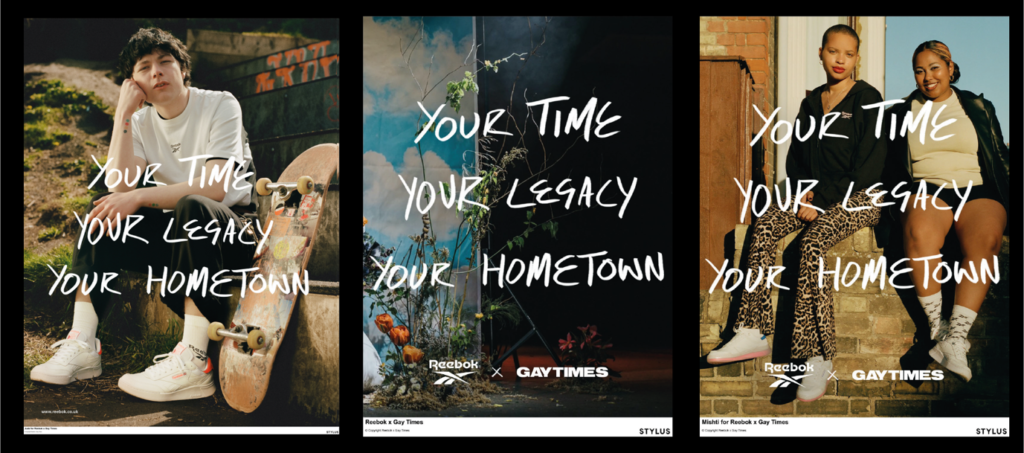The right to the rainbow?

Back in pride month we had much debate here at Interbrand London on the ‘right to the rainbow’. Today’s iconic flag is derived from the original 1977 design1 and has become a way for brands to make a statement in June (Pride month). What that statement is however and when brands should make these, is the cause of debate:
A statement of solidarity? A statement of internal core values supported by year round action? A vehicle of awareness? Or simply pure unadulterated commerciality?
Our debate – Do brands have permission to commercialise an event that at its heart is still a political protest, and if so what are their responsibilities?
Pride is a celebration and a political march by the LGBTQI+ community. The latter word being quite important. A ‘community’ of diverse people in cities across the planet, large and small, each linked yet distinctly local and often in support of local charities raising money for grass-roots LGBTQI+ community groups. People come together to celebrate, instilling hope and confidence for younger generations, gathering as one to share solidarity, help normalise LGBTQI+ families, remembering the atrocities of the past (events such as the Stonewall riots) and protest the ones still occurring today: “At least 76 countries criminalize consensual same-sex relationships, exposing millions of individuals to the risk of arrest, prosecution and imprisonment – and in at least five countries, the death penalty”2. And today there are still only 30 countries where same-sex marriage is legal3. Pride is not just a brightly coloured party, it is a political protest and act of human rights and still a brave and dangerous statement to make in many areas of the world.
As Pride events attract more allies to join the celebration and brands have decided to enter the conversation, it’s important to not just project the party but to support the cause all year round.
The Rainbow flag, said to be commissioned by Harvey Milk, is incredibly symbolic and precious to the LGBTQI+ community. Gilbert Baker, an openly gay designer, political activist, army veteran and drag-queen created the rainbow flag for the 1978 San Francisco Pride Parade to reflect the people within the LGBTQI+ community, their hopes and the Pride movement. Rumoured to have been inspired by / or as a tribute to ‘Over the Rainbow’ from the Wizard of Oz it transcends boarders, cultures and is a representation of a global LGBTQI+ family and a worldwide freedom struggle4. There is thought and consideration behind every colour in the flag – each represents an aspect of the Pride movement: Sex, Life, Healing, Sunlight, Nature, Magic/Art, Serenity and Spirit5.
As Pride events attract more allies to join the celebration and brands have decided to enter the conversation, it’s important to not just project the party but to support the cause all year round.

So where do brands come into the story?
From the 14th Annual LGBTQI+ Survey we have seen that 85% of the global LGBTQI+ community feel that businesses genuinely supporting LGBTQI+ equality is more important than ever6. “Nearly three quarters (73%) of those interviewed had made a conscious decision to make a purchase from a brand due to its LGBTQI+ inclusive outreach, employee practices or supportive political stance”7. However how do you know which brands are living the values vs ‘rainbow-washing’?
Just 32% of marketers in Britain engage with the LGBTQI+ community independently of Pride8. It’s hypocritical at best considering the barrage of rainbows plastered on high street windows and on-shelf. This lack of engagement year round leads to the community feeling their representation is tokenistic9. Large global brands such as UPS & Fed-Ex have rainbow washed despite donating millions to Anti-gay politicians in the US10. It’s simply not good enough.
So is the future is bright? 2021 sees a shift towards brands wearing the flag being more true to their colours – highlighting their own LGBTQI+ staff or more genuine stories or initiatives11. Despite some online backlash LEGO’s non-gendered rainbow figurines were created by gay designer Mathew Ashton, to allow builders to play with figures that do not present a pre-determined cultural adoption of how gender dresses, talks or behaves. Play how you identify.

Brands can become allies and even advocates12 to the cause – there is still so much work and action to de done against discrimination, disadvantage and education:
Ikea developed a fully inclusive work environment and is proud that over half its workforce is made up of minorities. Each branch has its own diversity and inclusion ambassador who work year round to support staff. They were a co-creator of the United Nations Standards of Conduct focusing on discrimination against LGBTQI+ people in the workplace13.
Visa has also supported these best practises produced by the UN Human Rights Office. Visa have held a 100% rating on the Human Right Campaign Corporate Equality Index for 5 years and are known for one of the best places to work for LGBTQI+ equality14.
Reebok has embraced the party and the local community cause. While paying homage to NYC / Harlem ballroom culture and ‘voguing’ through a line of pride footwear and a campaign supporting the significance of safe spaces for people to transform and express their identities; they have also partnered locally in the UK with publication Gay Times, following the stories of LGBTQI+ teenagers in Northern England15.

And smaller niche companies are also joining in the spirit of social inclusion and the hope of equality for all human beings: Manley Sound in the US have created a limited edition run of their VoxBox voice processor in a rainbow ombre skin. The Vox Aequalitatem translates as ‘All voices are equal’ 16 and all proceeds of the sales go to the Human Rights Campaign charity, which envisions a world where every member of the LGBTQI+ family has the freedom to live their truth without fear, and with equality under law17.
Pride is not just an event in June, it is a year round commitment to people. Brands in this case bear a responsibility to be an ally or advocate to support, reflect or champion the people within their company and/or those buying their products or services.
Brands that wear the rainbow must: understand and show a respect for the cause, celebrate the culture and show recognition/ support to the community.
- https://www.britannica.com/story/how-did-the-rainbow-flag-become-a-symbol-of-lgbt-pride
- https://www.unfe.org/system/unfe-43-UN_Fact_Sheets_-FINAL–Criminalization(1).pdf
- https://www.hrc.org/resources/marriage-equality-around-the-world
- https://www.britannica.com/story/how-did-the-rainbow-flag-become-a-symbol-of-lgbt-pride
https://www.rd.com/article/how-the-rainbow-became-associated-with-gay-rights/ - https://gilbertbaker.com/rainblow-flag-color-meanings/
- https://www.stylus.com/brands-back-pride-2021 – Stylus Media Group 2021
- https://www.stylus.com/brands-back-pride-2021 – Stylus Media Group 2021
- https://karmarama.com/2020/06/30/positive-perception-of-lgbtq-representation-within-advertising-drops/
- https://karmarama.com/2020/06/30/positive-perception-of-lgbtq-representation-within-advertising-drops/
- https://www.forbes.com/sites/dawnstaceyennis/2019/06/24/dont-let-that-rainbow-logo-fool-you-these-corporations-donated-millions-to-anti-gay-politicians/?sh=7acfc33f14a6
- https://www.stylus.com/brands-back-pride-2021 – Stylus Media Group 2021
- https://theconversation.com/are-companies-that-support-pride-and-other-social-causes-wokewashing-162150
- https://ripplematch.com/journal/article/companies-with-impactful-initiatives-to-support-their-lgbtq-employees-ce4be06a/
- https://www.glassdoor.co.uk/blog/amazing-companies-that-champion-lgbtq-equality-hiring-now/
- https://www.stylus.com/brands-back-pride-2021 – Stylus Media Group 2021
- https://www.manley.com/news/2021/6/25/voxbox-pride
- https://www.hrc.org